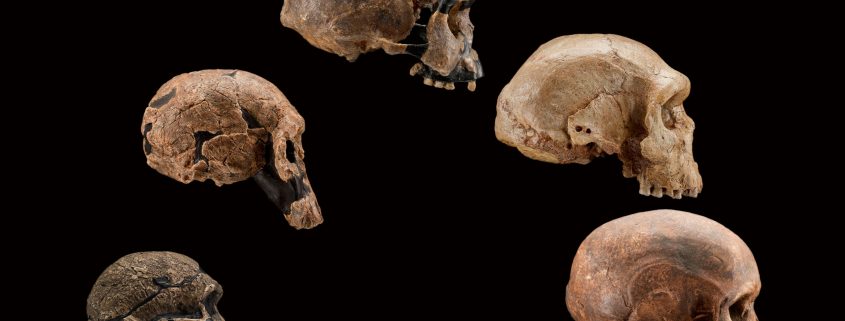what does it mean to be human?

Five fossil human skulls show how the shape of the face and braincase of early humans changed over the past 2.5 million years.
How do you define human?! Coinciding with the 100th anniversary of its official opening on the Mall, the National Museum of Natural History plans to open a new Hall of Human Origins based on decades of cutting-edge research by Smithsonian scientists. Part of its broader “Human Origins: What Does it Mean to be Human?” initiative, the Hall transports visitors through a dramatic time tunnel depicting human life and environments over the past 6 million years. The epic story of human evolution is told through the drama of climate change, and shows how survival and extinction have characterized our ancient human past.
Forensically reconstructed faces of early humans, a display of more than 75 skulls, and an interactive 6 million-year-old family tree are highlights in the Hall. Can’t visit? Not to worry. The Museum and National Geographic are publishing a book, What Does It Mean to be Human?; PBS will air a three-part series later in the year entitled, “Becoming Human: Unearthing Our Earliest Ancestors;” and the Museum will completely reproduce the exhibition through the Blue Mars virtual world website.
As always, scholars, research and related collections are available to Affiliates for public or school programs, exhibitions, or however you spin your own human story. Interested in collaborating? Contact your outreach manager at
So come by this spring to meet your ancient ancestors. And be sure to wish them a happy birthday.



Greetings! Nice post. Very useful [url=https://memorybedstore.com/index.php?action=profile;u=26114
indeed![/url]
oh god… https://bit.ly/hRPJwt
Could you name the skulls please?
Thank you for a great question! We’re consulting with the Hall’s scientists for the accurate answer for you. Check back soon!
Hi Mitchell:
According to Dr. Briana L. Pobiner of the Human Origins team at the National Museum of Natural History, here’s the identification on those skulls. From left to right: (Listed is the species name, specimen number, country, and date)
Australopithecus africanus
STS 5 (South Africa)
~2.5 million years old
Homo rudolfensis
KNM-ER 1470 (Kenya)
~1.9 million years old
Homo erectus
Sangiran 17 (Indonesia)
~ 1 million years old
Homo heidelbergensis
Petralona (Greece)
~350,000 years old
Homo sapiens
Fish Hoek 1 (Republic of South Africa)
~4,800 years old
Thanks again for your question, and for reading the Affiliate blog!